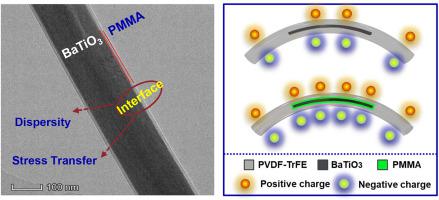Nano Energy ( IF 16.8 ) Pub Date : 2020-10-17 , DOI: 10.1016/j.nanoen.2020.105515
Kunming Shi , Bin Chai , Haiyang Zou , Peiyue Shen , Bin Sun , Pingkai Jiang , Zhiwen Shi , Xingyi Huang

|
Nanocomposites consisting of a flexible piezoelectric polymer and a reinforcing phase have shown great potential for constructing high-performance piezoelectric nanogenerators (PENGs). However, the weak interface and poor dispersion of piezoelectric reinforcing phase significantly impair the electromechanical properties (e.g., effective stress/strain, piezoelectric coefficients) of the nanocomposites, thus severely restricting the performance enhancement of the PENGs. In this study, we hydrothermally synthesized the piezoelectric reinforcing phase of BaTiO3 nanowires, and grafted a layer of high-modulus polymethyl methacrylate (PMMA) onto the nanowire surface via surface-initiated polymerization. The PMMA coating layer forms a strong interface between BaTiO3 nanowires and the polymer matrix [i.e., poly(vinylidenefluoride-co-trifluoroethylene)], which efficiently improves dispersion of the BaTiO3 nanowires and stress transfer at the interface, therefore resulting in an enhanced output performance in the fibrous nanocomposite PENGs. The output voltage and current of the PMMA encapsulated BaTiO3 (PMMA@BaTiO3) nanowires-based PENG can reach to 12.6 V and 1.30 μA, with a maximum output power of 4.25 μW, which is 2.2 times and 7.6 times higher than the PENG with unmodified BaTiO3 nanowires and the PENG without BaTiO3 nanowires, respectively. Furthermore, the flexible PENG exhibits great stability that could continuously generate stable electrical pulses for 6000 cycles without any decline. This study provides a feasible approach of interface tailoring for achieving high-performance piezoelectric nanocomposite and shows the promising potential of the fibrous nanocomposites in biomechanical energy harvesters and smart wearable sensors.
中文翻译:

柔性BaTiO 3 / PVDF-TrFE基压电纳米发生器中界面诱导的性能增强
由柔性压电聚合物和增强相组成的纳米复合材料已显示出构建高性能压电纳米发电机(PENG)的巨大潜力。然而,压电增强相的弱界面和差的分散性显着损害纳米复合材料的机电性能(例如,有效应力/应变,压电系数),从而严重限制了PENGs的性能增强。在这项研究中,我们水热合成了BaTiO 3纳米线的压电增强相,并通过表面引发的聚合反应将一层高模量的聚甲基丙烯酸甲酯(PMMA)接枝到了纳米线表面。PMMA涂层在BaTiO 3之间形成牢固的界面纳米线和聚合物基体(即,聚偏二氟乙烯-共三氟乙烯),可有效改善BaTiO 3纳米线的分散性和界面处的应力转移,因此可在纤维纳米复合材料PENG中提高输出性能。基于PMMA封装的BaTiO 3(PMMA @ BaTiO 3)纳米线的PENG的输出电压和电流可以达到12.6 V和1.30μA,最大输出功率为4.25μW,分别是PENG的2.2倍和7.6倍。与未改性的BaTiO 3纳米线和没有的BaTiO的彭3纳米线。此外,柔性PENG表现出很高的稳定性,可以连续产生稳定的电脉冲达6000个周期,而不会下降。这项研究为实现高性能压电纳米复合材料提供了一种界面定制的可行方法,并显示了纤维纳米复合材料在生物力学能量收集器和智能可穿戴传感器中的潜在潜力。































 京公网安备 11010802027423号
京公网安备 11010802027423号